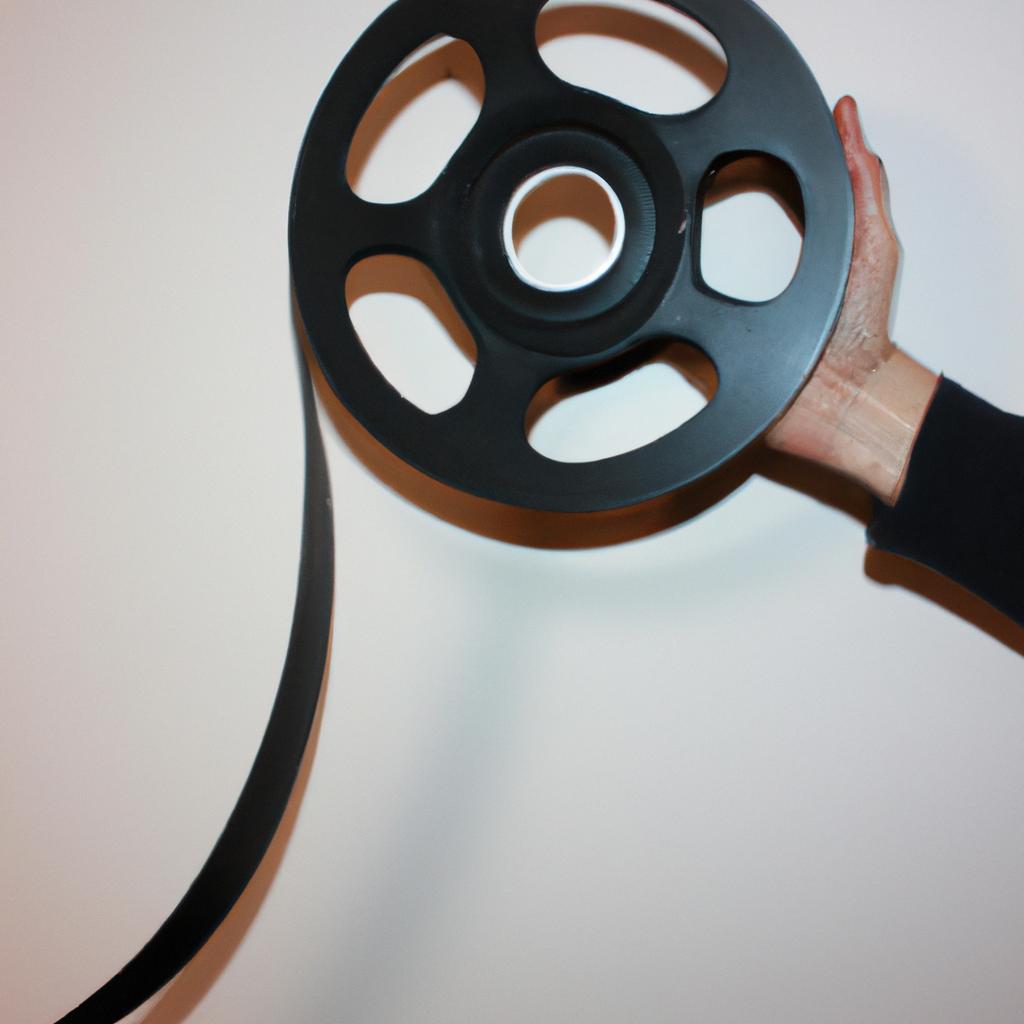Directing: Mastering the Art of Film in Arts and Entertainment

Directing is an essential component in the realm of film production, serving as the guiding force behind every creative decision and ensuring a cohesive vision. A masterful director possesses both technical expertise and artistic sensibility, seamlessly merging these skills to bring forth compelling narratives that resonate with audiences. For instance, imagine a hypothetical scenario where a director embarks on the creation of a thought-provoking drama set during World War II. Through meticulous attention to detail and precise execution of each scene, the director not only captures the authentic essence of the time period but also elicits powerful emotions from viewers through nuanced performances and evocative cinematography.
In this article, we will delve into the intricacies of directing within the context of arts and entertainment, exploring how directors can elevate their craft to achieve excellence. By analyzing various aspects such as script interpretation, visual storytelling techniques, actor direction, and effective collaboration with other members of the filmmaking team, we aim to provide aspiring directors with valuable insights that can aid them in mastering this multifaceted art form. Furthermore, we will examine case studies featuring renowned directors who have left an indelible mark on cinematic history by pushing boundaries and redefining conventional norms. From Alfred Hitchcock’s suspense-filled thrillers to Martin Sc orcese’s gritty and visceral dramas, these directors have demonstrated the power of visionary storytelling and the impact it can have on audiences.
One crucial aspect of directing is script interpretation. A director must thoroughly analyze the screenplay, understanding not only its plot but also its underlying themes, character motivations, and emotional arcs. This deep understanding allows the director to make informed decisions about how to visually bring the story to life, choosing appropriate camera angles, lighting techniques, and set designs that enhance the narrative’s intended impact.
Visual storytelling techniques are another essential tool in a director’s arsenal. Through careful shot composition, framing, and camera movements, a director can effectively convey information, evoke specific emotions, or build tension within a scene. Whether it’s using long takes to create a sense of realism or employing unconventional editing techniques to disorient viewers, visual storytelling plays a vital role in shaping the audience’s perception and engagement with the film.
Working with actors is another critical responsibility of a director. A skilled director understands how to communicate their vision effectively to performers while also allowing them creative freedom to bring their characters to life. By providing clear direction, offering constructive feedback, and fostering a collaborative environment on set, a director can elicit nuanced performances that resonate with audiences on an emotional level.
Lastly, successful directing relies heavily on effective collaboration with other members of the filmmaking team. From cinematographers and production designers to editors and composers, each department contributes unique expertise that enhances the overall cinematic experience. A director must be able to articulate their vision clearly while also being open to input from others who may offer valuable insights or suggestions.
In conclusion, directing is both an art form and a technical skill that requires a multifaceted approach. By mastering script interpretation, visual storytelling techniques, actor direction, and collaboration with other filmmakers, directors can elevate their craft and create films that captivate audiences for generations to come.
The Role of a Director in the Creative Process
Imagine a film set bustling with activity – lights, cameras, and actors all waiting for direction. In this dynamic environment, the director takes center stage, orchestrating every aspect of the production to bring their artistic vision to life. The role of a director in the creative process is crucial, serving as the guiding force that shapes the overall narrative and aesthetic of a film.
To fully understand the significance of a director’s role, it is essential to recognize their responsibilities within the filmmaking process. Firstly, directors are tasked with interpreting and translating scripts into visual storytelling. They must have a deep understanding of character development, plot structure, and thematic elements to effectively convey emotions and messages on screen. For example, consider Martin Scorsese’s acclaimed film “Taxi Driver,” where he skillfully captures the psychological turmoil of its protagonist through his meticulous use of camera angles, lighting techniques, and sound design.
In addition to script interpretation, directors also play a vital role in managing various creative aspects during filming. This involves collaborating closely with cinematographers on shot composition and framing choices to enhance visual impact. Furthermore, directors work hand-in-hand with costume designers, production designers, and other departments to ensure cohesive aesthetics aligning with their artistic vision.
As we delve deeper into understanding the multifaceted nature of directing, it becomes clear that effective communication lies at its core. Directors must possess strong leadership skills to guide actors in delivering compelling performances while maintaining consistency throughout different scenes or takes. Moreover, they need to foster an atmosphere conducive to creativity by encouraging collaboration among cast and crew members.
To illustrate further how impactful these roles can be emotionally:
- Unleashing Emotions: Directors have the power to evoke raw emotions from both characters and audiences alike.
- Creating Authentic Connections: Through skilled direction and storytelling techniques; characters connect deeply with viewers’ own experiences.
- Crafting Memorable Moments: Directors can create unforgettable scenes that resonate long after the film ends.
- Transporting Audiences: A well-directed film has the ability to transport audiences into different worlds and realities, providing an escape from everyday life.
Additionally, let’s take a look at how directors influence various aspects of filmmaking through this table:
| Aspects of Filmmaking | Director’s Influence |
|---|---|
| Cinematography | Shot composition, framing choices |
| Acting | Guidance on character development, performance delivery |
| Production Design | Cohesive aesthetics aligned with vision |
| Sound Design | Enhancing storytelling through audio elements |
In conclusion, the role of a director in the creative process is far-reaching and essential to bringing films to life. Their interpretation and translation of scripts, collaboration with various departments, effective communication skills, and emotional impact make them instrumental figures behind successful productions. Understanding their power in visual storytelling paves the way for exploring its profound effects on both filmmakers and audiences alike.
Moving forward into our next section about “Understanding the Power of Visual Storytelling,” we will delve deeper into how directors harness their unique abilities to captivate viewers’ imagination and emotions.
Understanding the Power of Visual Storytelling
With an understanding of the importance of a director’s role in the creative process, we now delve into the power of visual storytelling. Visual storytelling is a fundamental aspect of filmmaking that allows directors to convey emotions, engage audiences, and communicate complex ideas. To illustrate this concept, let us consider a hypothetical example: a director wants to depict the struggles faced by immigrants in their pursuit of the American dream.
Firstly, one powerful tool at a director’s disposal is mise-en-scène, which refers to everything within the frame of a shot. In our hypothetical example, the director could use lighting techniques to create contrasting moods – warm and inviting tones when depicting moments of hope and darkness or shadows during challenging times. The choice of costumes can also contribute significantly to conveying character traits and enhancing narrative elements. By carefully orchestrating every element within each frame, directors can effectively immerse audiences in captivating stories.
Furthermore, camera angles and movements play crucial roles in visual storytelling. A low-angle shot looking up at characters might evoke feelings of admiration or dominance while heightening tension or emphasizing power dynamics between characters. On the other hand, handheld shots can add authenticity and intimacy to scenes with emotional intensity or fast-paced action sequences involving our immigrant characters navigating unfamiliar environments.
To further emphasize the impact of visual storytelling on audience engagement, here are some key points worth considering:
- It enhances immersion by creating vivid worlds that captivate viewers.
- It fosters empathy by allowing audiences to step into characters’ shoes.
- It conveys information efficiently through visuals rather than exposition-heavy dialogue.
- It provides avenues for artistic expression through unique cinematography choices.
In summary, mastering visual storytelling is essential for directors seeking to deliver impactful narratives. Through careful manipulation of mise-en-scène and thoughtful selection of camera angles and movements, directors have the ability to transport audiences into rich cinematic experiences that provoke deep emotional responses.
As we explore the multifaceted role of a director in filmmaking, it is essential to highlight the importance of building a strong collaborative relationship with actors. This partnership forms the foundation for bringing characters and stories to life on screen.
Building a Strong Collaborative Relationship with Actors
Having explored the power of visual storytelling, we now turn our attention to building a strong collaborative relationship with actors. This section delves into the intricate dynamics between directors and actors, emphasizing the importance of effective communication and mutual trust in bringing characters to life on screen.
Developing a strong rapport with actors is crucial for a director seeking to elicit authentic performances. Consider the case study of acclaimed director Martin Scorsese’s collaboration with actor Robert De Niro. In their numerous collaborations, such as “Taxi Driver” and “Raging Bull,” Scorsese and De Niro developed an extraordinary level of understanding, resulting in compelling portrayals that captivated audiences worldwide. This example illustrates how a solid director-actor partnership can elevate the overall quality of a film.
To cultivate successful relationships with actors, directors should consider these key points:
- Establish open lines of communication: Encourage actors to share their insights, thoughts, and concerns about their characters. By fostering an environment where ideas are welcomed, directors empower actors to contribute meaningfully to the creative process.
- Provide clear guidance: Directors must effectively communicate their vision for each scene while allowing room for actor interpretation. Clear direction helps actors understand what emotions or motivations they need to convey without stifling their artistic freedom.
- Foster trust through respect: Acting requires vulnerability and trust in oneself and one’s collaborators. Directors who demonstrate respect for an actor’s craft build confidence and encourage risk-taking, ultimately leading to more nuanced performances.
- Cultivate a supportive atmosphere: Creating an atmosphere free from judgment allows actors to explore different approaches without fear of failure. Directors should foster an environment that encourages experimentation so that actors feel safe enough to take risks.
In order to facilitate fruitful collaborations with actors, it can be helpful for directors to refer back to this table:
| Key Points | Benefits |
|---|---|
| Open Communication | Fosters creativity and strengthens the bond between director and actor |
| Clear Guidance | Ensures a shared understanding of the desired performance |
| Trust and Respect | Encourages actors to fully commit to their roles and explore emotional depths |
| Supportive Atmosphere | Allows for experimentation, leading to more authentic performances |
By focusing on these principles, directors can forge strong relationships with actors that enhance the storytelling process. In our subsequent section on effective communication techniques on set, we will delve further into strategies that promote smooth collaboration between all members of a film crew.
Effective Communication Techniques on Set
Transitioning from the previous section on building a strong collaborative relationship with actors, it is crucial for directors to master effective communication techniques on set. By establishing clear lines of communication and employing various strategies, directors can ensure that their vision is effectively conveyed to the entire cast and crew, leading to a more cohesive and successful film production.
One example of an effective communication technique is utilizing storyboards or shot lists to visually communicate the desired shots and camera angles. By providing a visual representation of each scene, directors can effectively convey their creative ideas to both the cinematographer and the rest of the crew. This not only helps streamline the filmmaking process but also ensures that everyone involved is working towards a common goal.
To further enhance communication on set, directors should encourage open dialogue among all team members. Creating an environment where everyone feels comfortable expressing their opinions fosters collaboration and creativity. Additionally, regular meetings before shooting each scene can help establish expectations and allow for any necessary adjustments or clarifications to be made.
In order to evoke an emotional response in the audience while maintaining efficient communication, consider implementing these bullet points:
- Foster trust: Building trust between the director and actors enhances communication by allowing for honest feedback and constructive criticism.
- Use non-verbal cues: Directors can utilize body language or facial expressions during rehearsals or on set to effectively communicate emotions or specific actions they want from actors.
- Be adaptable: Being flexible in one’s approach allows room for creative input from others while still maintaining control over the artistic direction.
- Provide clear instructions: Using concise and precise language when giving directions reduces confusion and increases efficiency during filming.
Furthermore, incorporating this table into discussions about effective communication techniques emphasizes key aspects related to fostering collaboration on set:
| Communication Technique | Description |
|---|---|
| Active Listening | Paying full attention to what others are saying without interruption or distraction. |
| Feedback | Giving constructive feedback enables growth and improvement. |
| Empathy | Understanding and sharing the feelings of others promotes a supportive atmosphere. |
| Clarity | Using clear and concise language helps to avoid misunderstandings or ambiguity. |
As directors master effective communication techniques on set, they pave the way for successful collaborations with their actors and crew members. This not only enhances the overall quality of the film but also creates an environment that fosters creativity and innovation.
Transitioning into the subsequent section about managing time and resources in film production, it is essential for directors to balance effective communication with efficient use of these valuable assets.
Managing Time and Resources in Film Production
As filmmakers strive to effectively communicate on set, another crucial aspect of successful film production is managing time and resources. By efficiently utilizing available resources and adhering to a well-structured timeline, filmmakers can ensure that their projects stay on track and within budget. To illustrate this, let’s consider the hypothetical case study of an independent filmmaker working on a tight schedule and limited funds.
Paragraph 1:
In our case study, the filmmaker faces several challenges due to resource constraints. The first step in managing time and resources is conducting thorough pre-production planning. This involves creating detailed schedules, organizing shooting locations, securing necessary equipment, and assembling a skilled crew. By carefully assessing each element required for the film production process, the filmmaker can identify potential bottlenecks or areas where additional resources may be needed.
To further highlight the significance of effective resource management in film production, consider the following bullet points:
- Efficiently allocating budgetary resources
- Ensuring timely delivery of props and costumes
- Streamlining post-production processes
- Minimizing wastage through careful inventory control
Paragraph 2:
To facilitate efficient resource allocation and scheduling, many filmmakers utilize project management tools such as Gantt charts or digital collaboration platforms. These tools help visualize timelines, assign tasks to team members, monitor progress, and make adjustments when necessary. Additionally, maintaining open lines of communication with all stakeholders throughout the filmmaking process allows for quick decision-making and problem-solving.
To emphasize key aspects of managing time and resources in film production further, here is a table outlining different stages of production along with associated considerations:
| Stage | Considerations |
|---|---|
| Pre-production | Casting choices |
| Location scouting | |
| Equipment rental | |
| Production | Shooting schedule |
| Crew coordination | |
| Set construction | |
| Post-production | Editing timeline |
| Visual effects planning | |
| Sound design and mixing |
Paragraph 3:
By effectively managing time and resources, filmmakers can not only ensure the smooth operation of their projects but also maintain creative integrity. Balancing artistic vision with commercial success is an ongoing challenge in the film industry. In the subsequent section, we will explore strategies to strike this delicate balance while navigating the dynamic landscape of arts and entertainment.
Transition into the subsequent section:
Understanding the importance of managing time and resources, it becomes crucial to address how filmmakers can successfully balance their artistic vision with commercial success. This requires careful consideration of various factors such as audience appeal, market trends, and financial viability. Let us now delve into these considerations in our exploration of “Balancing Artistic Vision with Commercial Success.”
Balancing Artistic Vision with Commercial Success
Transitioning from the previous section, where we explored the importance of managing time and resources in film production, let us now delve into another crucial aspect: balancing artistic vision with commercial success. This delicate equilibrium is essential for filmmakers who aspire to create impactful works while also achieving financial viability.
To illustrate this concept, let’s consider a hypothetical scenario involving a young director named Emily. Emily has an innovative and unique artistic vision for her debut feature film. She wants to challenge conventional storytelling techniques and push boundaries within the art form. However, she must also ensure that her film appeals to a wide audience, as securing funding and distribution are critical milestones in launching her career.
Achieving balance between artistic integrity and commercial success requires careful consideration of various factors:
-
Target Audience Identification:
- Determine the demographic most likely to resonate with your film.
- Understand their preferences, tastes, and consumption habits.
- Tailor your artistic choices accordingly without compromising your core vision.
-
Strategic Marketing Approach:
- Develop effective marketing campaigns that highlight both the artistic merits and commercial appeal of your project.
- Create promotional materials that convey the essence of your work while enticing potential viewers.
-
Budget Allocation:
- Allocate funds wisely by prioritizing aspects that enhance both creative quality and marketability.
- Strike a balance between allocating resources towards innovative filmmaking techniques and ensuring profitability.
-
Collaborative Decision-Making:
- Engage in open dialogue with producers, distributors, and other stakeholders involved in the project.
- Seek expert opinions on how certain artistic choices may impact commercial prospects.
A table highlighting these key points could be effectively utilized:
| Factors | Considerations |
|---|---|
| Target Audience Identification | Demographic analysis |
| Preferences and tastes | |
| Consumption habits | |
| Strategic Marketing Approach | Highlighting artistic merits |
| Emphasizing commercial appeal | |
| Crafting enticing promotions | |
| Budget Allocation | Prioritizing creative quality |
| Ensuring profitability | |
| Collaborative Decision-Making | Open dialogue with stakeholders |
| Expert opinions on artistic choices |
By carefully navigating these considerations, filmmakers like Emily can strike a balance between their artistic vision and commercial success. This delicate equilibrium is not always easy to achieve, but it is crucial for those aiming to make an impact in the film industry.
In summary, balancing artistic vision with commercial success requires thoughtful consideration of target audience identification, strategic marketing approaches, budget allocation, and collaborative decision-making. By finding harmony between these elements, filmmakers can create compelling works that resonate with audiences while also achieving financial viability.






